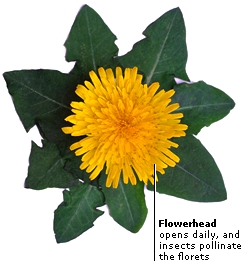DK Science: Seed Plants
Most plants grow from seeds. These seed plants fall into two groups, angiosperms and gymnosperms. Angiosperms are the flowering plants. Their seeds develop inside a female reproductive part of the flower, called the ovary, which usually ripens into a protective FRUIT. Gymnosperms (conifers, Ginkgo, and cycads) do not have flowers or ovaries. Their seeds mature inside cones. Seeds may be carried away from the parent plant by wind, water, or animals.

Dandelion seeds have feathery parachutes to help them fly far from their parent plant. A dandelion flower is actually made up of many small flowers, called florets. Each develops a single fruit. The fruits form inside the closed-up seed head, after the yellow petals have withered away. When the weather is dry, the seed head opens, revealing a ball of parachutes. The slightest breeze lifts the parachutes into the air.
A seed is the first stage in the life cycle of a plant. Protected inside the tough seed coat, or testa, is the baby plant, called an embryo. Food, which fuels germination and growth, is either packed around the embryo or stored in special seed leaves, called cotyledons.
Seeds are not the only means of reproduction. Some plants create offshoots of themselves – in the form of bulbs, tubers, corms, or rhizomes – that can grow into new plants. This type of reproduction is called vegetative reproduction. As only one parent plant is needed, the offspring is a clone of its parent.
A bulb is an underground bud with swollen leaf bases. Its food store allows flowers and leaves to grow quickly. New bulbs develop around the old one.
A tuber is a swollen stem or root with buds on its surface. When conditions are right, the tuber’s food store allows the buds to grow.
A corm is a swollen underground stem that provides energy for a growing bud. After the food in the old corm is used up, a new corm forms above it.
Most seeds require damp, warm conditions in order to sprout. During germination, the seed absorbs water and the embryo starts to use its food store. A young root, or radicle, begins to grow downward. Then a young shoot, or plumule, grows upward. This develops into the stem and produces leaves. The first leaves, called seed leaves or cotyledons, fuel the early growth until the plant’s true leaves appear.
A flower’s ovary usually develops into a fruit to protect the seeds and help disperse them. A fruit may be succulent (fleshy) or dry. Fruit is often tasty and colourful to attract fruit-eating animals. Its seeds can pass through an animal unharmed, falling to the ground in droppings. Seeds may also be dispersed on animals’ coats, by the wind, or by the fruit bursting open.
The seeds of dry fruits are dispersed in various ways. Peapods are dry fruits that split and shoot out their seeds by force. The hogweed fruit forms a papery wing around the seed, helping it to float on the breeze. The strawberry is a false fruit, but it is covered by tiny dry fruits, each with a seed.
Fleshy, brightly coloured, and often scented, succulent fruits are designed to attract the animals that eat and disperse them. Fleshy fruits such as apricots and cherries have a woody stone or pip that protects the seed. Called drupes, these fruits form from a single ovary. Many drupes, formed from many ovaries, may cluster to form a compound fruit, such as a raspberry.


